| Sensors & Circles by Andy Shipsides (AbelCine) |
At AbelCine, one of the most common questions our techs get these days is about lens coverage with different cameras. It’s no wonder that we get these inquiries, as there’s an endless stream of new cameras coming out, all of which have different sensor sizes and specs. We frequently get questions like this: "Does my 16mm lens cover the Blackmagic Cinema Camera sensor?" or "Does my lens cover 6K on the RED DRAGON camera?" These are both great questions, which we can generally answer with a simple yes or no. But they bring up some really interesting points that all modern cinematographers need to understand when choosing a lens, camera and recording format. So this column is all about lenses, image circles, sensor sizes and resolutions. The best place to start is with the lens "image circle" and exactly what that means.
CIRCLES OF CONFUSION
When we talk about a lens, we often describe it by the film format or sensor size that it’s designed to work with. Super 35mm lenses are designed to work with Super 35mm film or sensors that are around the same size; Super 16mm lenses are designed to work with Super 16mm film or similar sensors, etc. This can be confusing in itself, as we talk about lens focal length in millimeters, as well. You can have a 35mm (focal length) Super 16mm lens, for instance, and a 16mm (focal length) Super 35mm lens.
When we describe a lens as being designed for Super35 or 16mm film, we’re actually talking about the image circle of a lens. Lenses are designed to project a circular image onto a sensor or film plane. The size of the projected image circle is based on the design of a lens. An average "Super 35mm" lens has an image circle diameter of around 32mm to 35mm, while an average "Super 16mm" lens has an image circle diameter of around 15mm to 18mm. Lenses designed for smaller formats, usually in video cameras, are often referred to in inches. A 2/3-inch-type lens has an image circle of around 11mm, and a 1/2-inch lens image circle is around 8mm.
In the graphic above, you see Super35, Super16, 2/3-inch and 1/2-inch image circles on top of each other. This photo was taken on a 50mm (focal length) lens. If it were a Super 35-type lens, we would get the outside image; if it were Super16, we would get the image outlined for that and so on. The focal length of the lens is exactly the same; we just get more of the image with the larger image circle. Focal length is unrelated to image circle, which is a big point of confusion for many of us. A 100mm lens has the same focal length, regardless of its lens type; the difference is just how big of an image circle it projects.
COVER ME!
So hopefully you understand the image circle concept. Now let’s discuss how it plays together with sensor (or film) size. Super 35mm film is standardized at 24.9×18.7mm (31.1 diagonal), but our modern digital sensors come in a variety of shapes and sizes. From the large full-frame 35mm sensors found in many DSLRs to the small 1/2.5-inch sensors found in many POV cameras, sensor sizes vary a lot. Below is a graphic with a variety of camera sensors overlaid in relative size. As you can see, each sensor is a bit different.

We say a lens "covers" a sensor when its image circle produces an image over the full sensor size. So how do we determine if a lens’ image projection will "cover" a specific sensor? Just overlay the two. Look at the graphic of the image circle of a Zeiss CP.2 prime lens (right), which produces an image circle of 43mm (diagonally), completely covering every sensor size from full-frame 35mm down to 1/3-inch sensors.
From the diagram, you can see that a Zeiss CP.2 will work with a huge variety of sensors. But what about a Super 16mm lens with a 15mm image circle?
In the graphic below, the Super 16mm lens doesn’t cover anything larger than the "Super16"-sensor type. That makes sense, of course, but notice what happens to all the larger sensors; they vignette. This is exactly what you would see if you put a Super 16mm lens on a camera like the ARRI ALEXA or Sony F55, which both have sensors around the size of Super 35mm film.
ANOTHER ASPECT
Okay, so lens coverage isn’t all that complicated when you compare sensor sizes to a lens image circle. But many modern cameras offer a variety of aspect ratios and resolution modes, which allow the camera to record different areas of its sensor. Cameras that have this option are effectively altering their sensor size. The RED DRAGON is a great example of a camera that has these modes.
In this graphic (below, right), I’ve overlaid a standard Super 35mm lens image circle over a DRAGON sensor. The lines over the sensor indicate different recording areas and aspect ratios. As you can see, the area outside the 6K image isn’t covered by the lens, but the inside areas are all covered just fine. So this lens doesn’t cover the 6K resolution area on the RED DRAGON.
This brings up another question: What does resolution have to do with lens coverage, anyway? The answer: Nothing. The 6K resolution area of the DRAGON is physically 30.7×15.8mm (34.5 diagonal) in dimension, meaning that each photosite on the sensor is around 4.9um (0.0049mm) in size. A different sensor type could have larger or smaller photosites in the same area, producing lower or higher resolutions.
IN CONCLUSION
Let’s go back to our original questions: "Does my 16mm lens cover the Blackmagic Cinema Camera sensor?" and "Does my lens cover 6K on the RED DRAGON camera?" Super 16mm lenses don’t cover the Blackmagic Cinema Camera sensor, as the image circle of Super16 glass is 15mm, and the BMCC sensor has a diagonal area of 18.4mm. As for the RED DRAGON at 6K, the answer depends on the lens image circle. Having a 6K resolution has nothing to do with lens coverage, but it does describe a large area of the sensor. Lenses like the Zeiss CP.2 primes and CPZ.2 zooms are designed to cover the larger full-frame-sensor cameras, so we know they will work. Other Super 35mm lenses generally won’t cover that image area, but the only way to know for sure is to test them. AbelCine’s technical blog and other online resources are available that list various image circles, so visit our site to learn more.
Andy Shipsides is a N.Y.-based Camera Technology Specialist and Manager of AbelCine’s Training Department. To learn more about AbelCine’s Understanding HD Series, you can visit their website at training.abelcine.com.
|
| |
| Duclos Image circle database |
|
2013 Duclos image circle
|
| |
| Fields of View by Abel Cine |
Link to Abel Cine Field of View Calculator - click here |
|
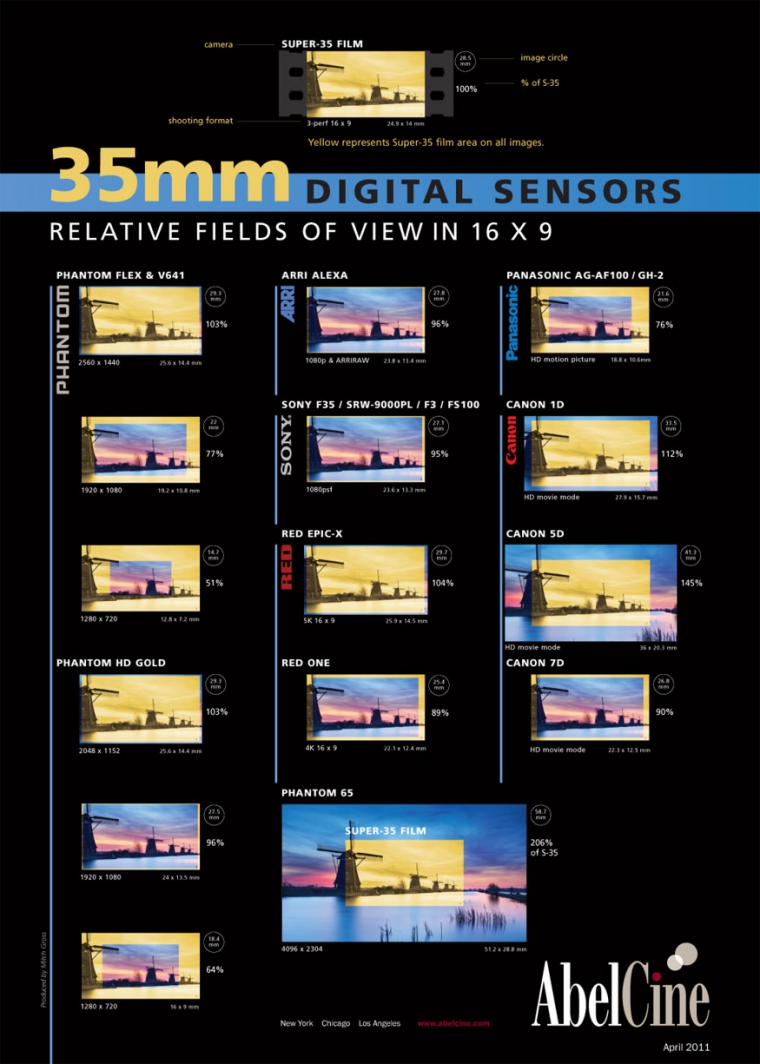
|
| |
| Lenses / Field of view |
A 50mm is a 50mm is a 50mm, is often said to explain the differences in formats versus focal lenghts . But what does it mean?
Of course it says: Any focal length is just that length no matter what you do with it.
Why does a 50mm on a 16mm/2K camera looks closer on a 35mm/4K camera?
The answer is simple, you just use a smaller area of the image. Since the image projected on the film plane/sensor is the same for a given focal length, the smaller image area only uses the centre part of it. In order to get the same shot, you will have to step back or closer with the camera or use a wider / longer lens. |
| |
| Focal lengths & Formats by Film and Digital times |
Link to the article:
https://www.fdtimes.com/2011/05/04/focal-lengths-format-sizes/ |
|
Focal lengths & Formats by Film and Digital times in PDF
|
| |
| Data sensor and Film size comparison |
Brand Model Sensor Size (mm) Image Circle (mm)
Arri LF 36.7 x 25.54 44.7 (Open gate)
Arri Alexa 23.8 x 13.4 27.3
Red W Monstro 8K 40.96 x 21.6 46.3
Red Dragon 30.7 x 15.8 34.5
Red Epic MX 27.7 x 14.6 31.4
Red One M 24.4 x 13.7 29.7
Canon C100/300/500 -24.5 x 13.8 28.2
Canon 5D/1DC 36 x 20.3 41.3
Canon 7D 22.3 x 12.5 26.8
Sony Venice 24 × 36 43.7
Sony F65/F3 -
FS100/ FS700 23.6 x 13.3 27.1
Sony F55 / F5 22.6 x 12.7 25.9
Black Magic (HD) 15.8 x 8.9 18.1
Digital Micro 4/3 17.3 x 13 21.64
Film S16mm 12.52 x 7.41 14.55
Film 35mm (acad) 22 x 16 27.2
Film S35mm 3 Perf 24.9 x 13.9 28.5
Film S35mm 4 Perf 24.9 x 18.66 31.12
Film Vista Vision 37.72 x 24.92 45.2
Film 65mm 5 Perf 52.51 x 23.07 57.35
Film 70mm IMAX 15-p 70.41 x 56.62 90.35 |
| |
| 2014 Camera comparison chart by Fletcher |
|
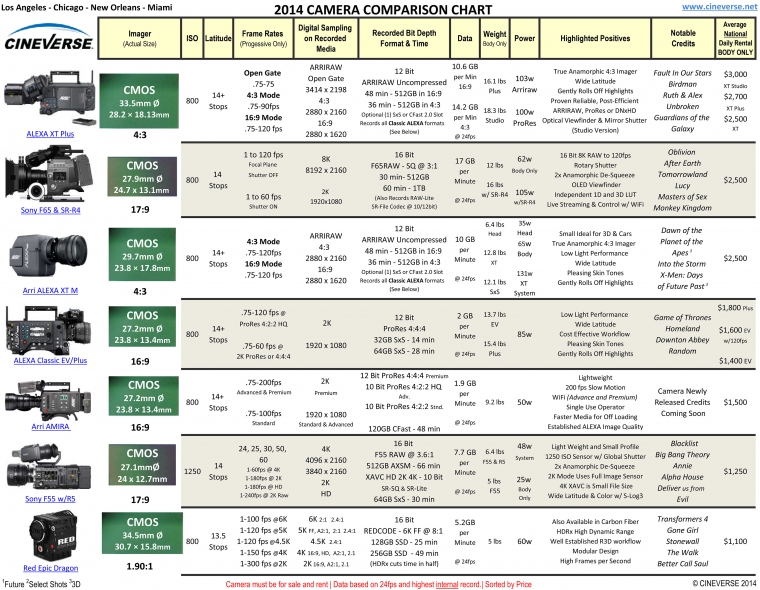
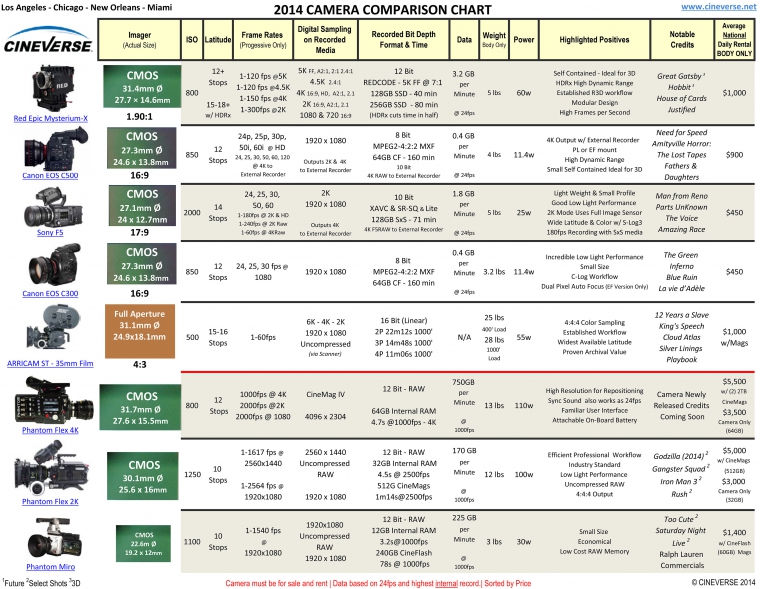
cameramarket_2014_Camera_Comparison_Chart_v10.pdf
|
| |
| 2012 Camera comparison chart by Fletcher |
|
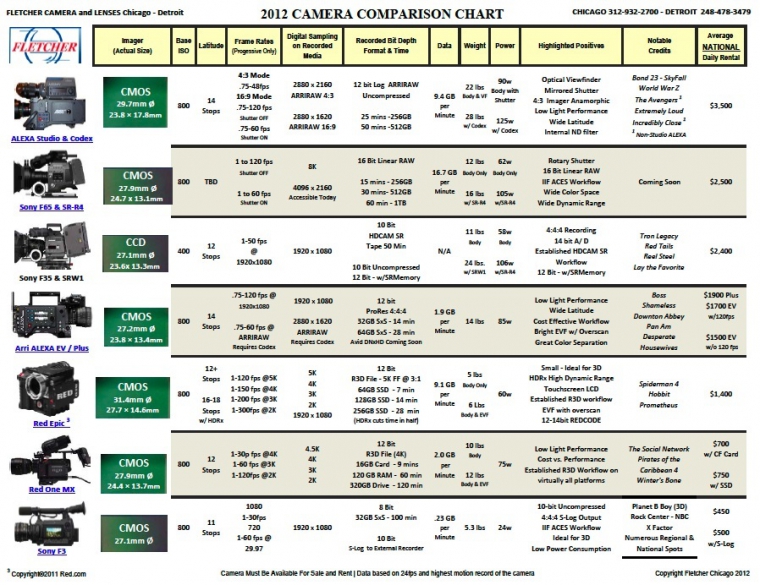
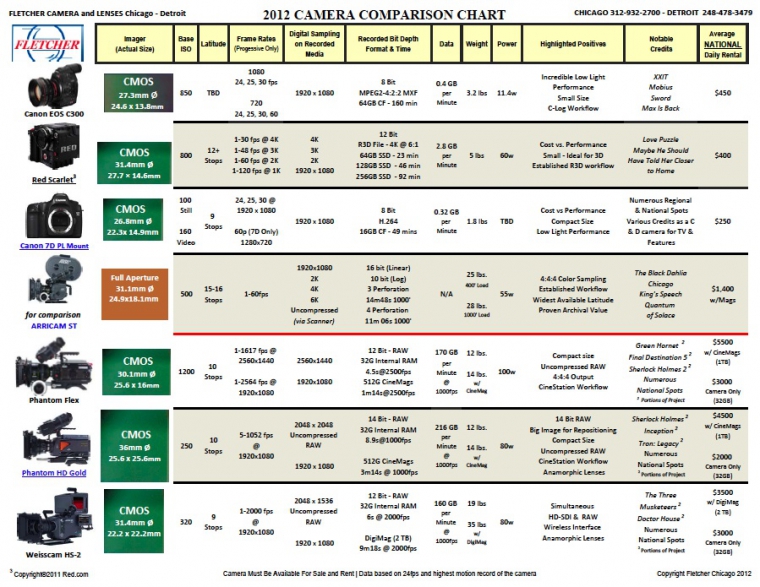
Camera comparison chart - Click to open PDF
|
| |
| Zoom lens comparison chart by Fletcher |
|
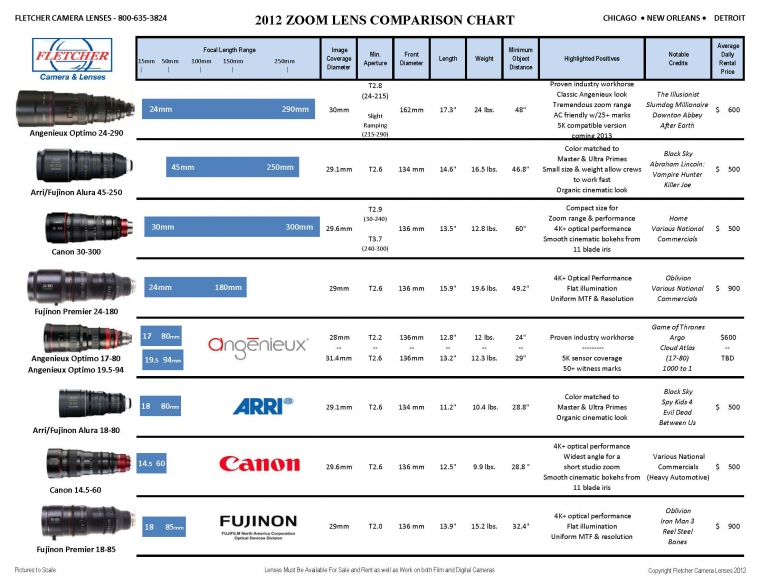
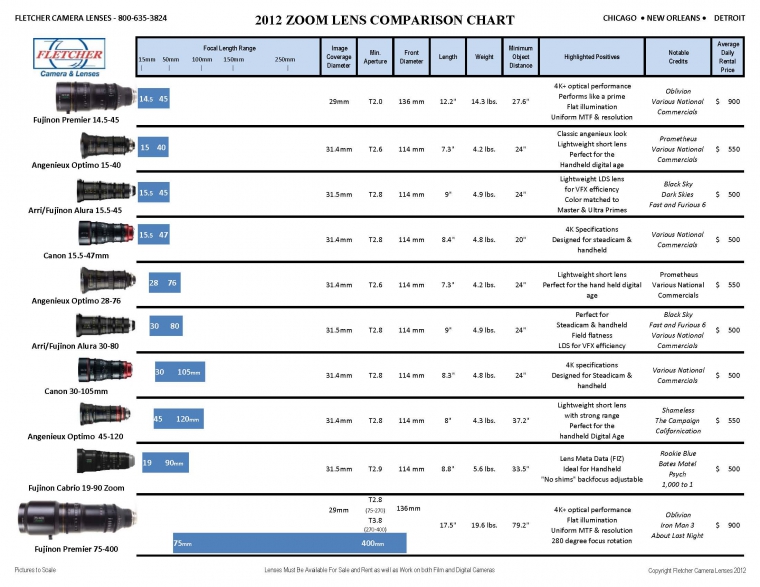
Zoom lens comparison - Click for PDF to open
|
| |
| What is Anamorphic? |
Contrary to popular belief "Anamorphic" is not a shooting aspect ratio, but a technique to record an image.
The traditional Anamorphic technique makes it possible to use the maximum of the film/sensor area when shooting a 1:2.35 frame. For this you need to crop (morph) the image x2 from the sides when you use a 4:3 / 1:1.33 image area.
This is academy format in 4-perf 35mm for example.
When using a 16:9 / 1:1.78 image area, it makes more sense to use the so-called 1.3 anamorphic lenses.
These lenses crop not x2, but x1.3 times.
Netto result is the same, you can use the maximum available image area and have a 1:2.35 frame in the end.
Since the end result is a 1:2.35 frame, people like to refer to this as "Anamorphic".
One of the trademarks of this technique is the depth of field, or better the lack of it.
Needless to say that the focuspuller will have a very hard time here.
To make the technique possible you will need longer lenses (2x) then when you would use with spheric (normal) lenses. This results in very little depth of field. A shooting T-stop of 5.6 is no luxury in this format. |
| |
| Optical Axis |
The optical axis has not much to do with the lens/camera very often. Only in case of static objects the lens/camera decides where the axis to a given object is. As soon as an object is moving that object often determines where the axis will go.
When shooting with actors, imagine that the talent in frame has a 3meter/10foot stick attached to their nose. Wherever the stick points is the optical axis.
I saw film students making tracks with the camera in order to get to the other side of the axis. Often a little change in staging, or even a different eye line does the trick. |
| |
| Lens mounts and flange focal distances |
Courtesy of Filmcentre.co.uk
Original link: http://www.filmcentre.co.uk/faq_lens_m.htm |
|
Lens mount and flange focal distance
|
| |
| 35mm / 4K prime lens specifications |
Arri Variprimes T-Stop Min.focus Weigth-lbs Front dia Iris blades
16-30 Zeiss T2.2 2ft 9.75
29-60 Zeiss T2.2 2ft 9.14
55-105 Zeiss T2.2 2ft 9in 12.25
35mm T2 Zeiss Standards T-Stop Min.focus Weigth-lbs Front dia Iris blades
10mm (Mk1) T2.1 7in 1.5
10mm T2.1 14in 7
12mm (Mk1) T2.1 7in 1.5
12mm T2.1 10in 2.5
14mm (Mk1) T2 2ft 3.5
14mm T2 9in 3.5
16mm T2.1 10in 1.25
20mm T2.1 8in 1.5
24mm T2.1 1ft 2in 1.25
28mm T2.1 11in 2.25
32mm T2.1 2ft 1
40mm T2.1 1ft 4in 1
50mm T2.1 1ft 6in 1.25
85mm T2.1 3ft 1.5
100mm T2.1 3ft 4in 1.75
135mm T2.1 5ft 2.25
180mm T3 5ft 2.5
Leica Thalia T-Stop Min.focus Weigth-lbs Front dia Iris blades
24mm T3.6 1ft 4in tbd 95mm 15
30mm T2.9 1ft 8in 3.3 95mm 15
35mm T2.6 1ft 10in 3.1 95mm 15
45mm T2.9 1ft 8in 3.2 95mm 15
55mm T2.8 2ft 4in tbd 95mm 15
70mm T2.6 1ft 8in 2.3 95mm 15
100mm T2.2 2ft 4in 2.5 95mm 15
120mm T2.6 1ft 10in tbd 95mm 15
180mm T3.6 5ft 3.6 95mm 15
Leica Summilux-C T-Stop Min.focus Weigth-lbs Front dia Iris blades
16mm T2.8 1ft 2in 3.7 95mm
18mm T1.4 1ft 2in 3.7 95mm
21mm T1.4 1ft 3.5 95mm
25mm T1.4 1ft 3.5 95mm
29mm T1.4 1ft 6in 3.7 95mm
35mm T1.4 1ft 2in 3.6 95mm
40mm T1.4 1ft 4in 3.6 95mm
50mm T1.4 1ft 8in 3.7 95mm
65mm T1.4 1ft 5in 3.7 95mm
75mm T1.4 2ft 3in 3.6 95mm
100mm T1.4 2ft 11in 3.5 95mm
135mm T1.4 4ft 1in 7.4 95mm
Leica Summicron-C T-Stop Min.focus Weigth-lbs Front dia Iris blades
15mm T2 1ft 4.1 95mm
18mm T2 1ft 2.9 95mm
21mm T2 1ft 2.9 95mm
25mm T2 1ft 3.4 95mm
29mm T2 1ft 3 95mm
35mm T2 1ft 2in 2.9 95mm
40mm T2 1ft 6in 3 95mm
50mm T2 2ft 3.2 95mm
75mm T2 2ft 7in 2.7 95mm
100mm T2 3ft 3in 2.7 95mm
135mm T2 5ft 4.1 95mm
Zeiss Ultraprimes T-Stop Min.focus Weigth-lbs Front dia Iris blades
8mmR T2.8 1ft 2in 4.4
10mm T2.1 1ft 2in 6.4
12mm T2 1ft 4.4
14mm T1.9 9in 4
16mm T1.9 10in 2.6
20mm T1.9 11in 2.6
24mm T1.9 1ft 2.2
28mm T1.9 11in 2.2
32mm T1.9 1ft 2in 2.4
40mm T1.9 1ft 3in 2.2
50mm T1.9 2ft 2.25
65mm T1.9 2ft3in 2.4
85mm T1.9 3ft 2.75
100mm T1.9 3ft 3in 2.6
135mm T1.9 5ft 3.5
180mm T1.9 8ft 6in 5.7
Zeiss Masterprimes T-Stop Min.focus Weigth-lbs Front dia Iris blades
12mm T1.3 16in 6.4
14mm T1.3 14in 5.3
16mm T1.3 14in 4.8
18mm T1.3 14in 4.8
21mm T1.3 14in 5.3
25mm T1.3 14in 5.1
27mm T1.3 14in 4.8
32mm T1.3 14in 5.1
35mm T1.3 14in 4.8
40mm T1.3 16in 5.1
50mm T1.3 20in 5.9
65mm T1.3 2ft 3in 5.7
75mm T1.3 2ft 9in 6.2
100mm T1.3 3ft 6in 6.4
135mm T1.3 3ft 3in 6.2
150mm T1.3 4ft 11in 8.8
Zeiss 35mm Mk3 Supersp. T-Stop Min.focus Weigth-lbs Front dia Iris blades
18mm T1.3 10in 2.5
25mm T1.3 10in 2
35mm T1.3 1ft 2in 1.75
50mm T1.3 2ft 4in 1.75
65mm T1.3 28in 2.25
85mm T1.3 3ft 2
Cooke Speed Pancro (orig.)T-Stop Min.focus Weigth-lbs Front dia Iris blades
18mm T2.3 8in 1.25
25mm T2.3 9in 1.25
32mm T2.3 14in 1.25
40mm T2.3 9in 1.5
50mm T2.3 18in 1.75
75mm T2.3 20in 2
100mm T2.8 2ft 2.5
152mm
203mm
406mm
Cooke S4 Primes T-Stop Min.focus Weigth-lbs Front dia Iris blades
12mm T2 9in 6.5 156 8
14mm T2 9in 4.8 110 8
16mm T2 9in 5.4 110 8
18mm T2 9in 3.9 110 8
21mm T2 9in 4.4 110 8
25mm T2 9in 3.5 110 8
27mm T2 10in 3.6 110 8
32mm T2 12in 4 110 8
40mm T2 16in 4.5 110 8
50mm T2 20in 3.3 110 8
65mm T2 27in 3.6 110 8
75mm T2 2ft 6in 3.9 110 8
100mm T2 3ft 4.5 110 8
135mm T2 2ft 6in 5.25 110 8
150mm T2 3ft 6in 7.7 125 8
180mm T2.8 6ft 1in 10.4 136 8
300mm T2.8 7ft 10.4 136
Cooke S5 Primes T-Stop Min.focus Weigth-lbs Covers Iris blades
18mm T1.4 14in 6.7 S35 30mm
25mm T1.4 14in 6.6 S35 30mm
32mm T1.4 14in 6.2 S35 30mm
40mm T1.4 16in 6.1 S35 30mm
50mm T1.4 20in 7.1 S35 30mm
65mm T1.4 2ft 6.8 S35 30mm
75mm T1.4 2ft 3in 6.6 S35 30mm
100mm T1.4 2ft 5in 6.4 S35 30mm
135mm T1.4 2ft 6in 11.3 S35 30mm
Cooke S7 Primes T-Stop Min.focus Weigth-lbs Front dia Iris blades Covers
18mm T2 16in 7.7 110mm 9 46.31mm
25mm T2 14in 7.3 110mm 9
32mm T2 14in 7.5 110mm 9
40mm T2 18in 7.7 110mm 9
50mm T2 1ft 7in 7.5 110mm 9
75mm T2 1ft 6in 6.6 110mm 9
100mm T2 2ft 5in 7.3 110mm 9
135mm T2 3ft 3in 8.2 110mm 9
Cooke miniS4 (Panchro) T-Stop Min.focus Weigth-lbs Front dia Iris blades
18mm T2.8 10in 3.9
25mm T2.8 10in 3.5
32mm T2.8 12in 4
50mm T2.8 20in 3.3
65mm T2.8
75mm T2.8 2ft 6in 3.9
100mm T2.8 3ft 4.5
135mm T2.8 3ft 3in 4.5
Panavision Primo 70 T-Stop Min.focus Weigth-lbs Front dia Iris blades Name
27mm T2 1ft 2in 4P27
35mm T2 1ft 2in 4P35
40mm T2 1ft 2in 4P40
50mm T2 1ft 4in 4P50
65mm T2 1ft 8in 4P65
80mm T2 2ft 4P80
100mm T2 2ft 6in 4P100
125mm T2 3ft 4P125
150mm T2 4ft 4P150
200mm T2.8 4ft 4P200
250mm T2.8 4ft 4P250
Arri Prime 65 T-Stop Min.focus Weigth-lbs Front dia Iris blades
24mm T4.8 1ft 3in
28mm T4 10in
35mm T3.5 1ft 8in
50mm T3.5 2ft
80mm T2.8 2ft 6in
100mm T2.2 2ft 11in
150mm T3.2 4ft 3in
300mm T4.5 8ft
Schneider Cine Xenar III T-Stop Min.focus Weigth-lbs Front dia Iris blades
14mm
18mm T2.2 11in 4.5
25mm T2.2 11in 4.1
35mm &nbs |
| |
| 35mm / 4K zoom lens format specifications |
35mm zoom lenses T-Stop Min.focus Weigth lbs Notes
14-70 Cooke T3.1 2ft 4in 16
14-35 ZK Fujinon LWZ T2.9 2ft 6,4
14.5-60 Canon T2.6 2ft 4in
14.5-45 Fujinon Premier T2 2ft 4in 14
15-40 Angenieux Optimo T2.6 2ft 4.2
15-42 Cooke S4i CXX T2 1ft 6in 8
15.5-45 Arri Fujinon/Alura T2.8 2ft 4.9
15.5-45 Zeiss LWZ-2 T2.6 1ft 6in 4.4
15.5-47 Canon T2.8 1ft 8in 4.8
16-42 Optimo DP Rouge T2.8 2ft 4.2
16.5-110 Zeiss Masterzoom T2.8 2ft3in 26.4 17.4'' / 443 mm length
17-35 Century Compact Zoom T3
17-50 Red zoom T2.9 2ft 2in 3.2
17-80 Angenieux Optimo T2.2 2ft
17-102 Angenieux T2.9 2ft 6in 19
17-120 Canon CN T3/T4 2ft 8in 5
18-80 Arri/Fujinon Alura T2.6 2ft 4in 10.5
18-85 Red zoom T2.9 2ft 2in 10
18-85 Fujinon premier T2 2ft 7in
18.5-55.5 Techno-Cooke T2.4 2ft 4in 8
18-90 Cooke T2.8 2ft 7in 12.5
18-100 Cooke T3 2ft 4in 13.75
19-90 Fujinon Cabrio T2.9 2ft 10in 5 6lbs with servo
19.5-94 Angenieux Optimo T2.6 2ft 5in 12.3
20-60 Cooke T3.1 2ft
20-100 Cooke T3.1 2ft 4in 11.5
20-120 Fujinon XK 6x T3.5 3ft 6in 5
24-180 Fujinon premier T2.6 4ft 1in 19,6
24-290 Angenieux Optimo T2.8 4ft 24 17.5 in length
25-250 Cooke MKII T4 5ft 6in 11.5
25-250 Cooke MKIII T3.7 5ft 6in 18
25-250 Techno-Cooke T2.5 7ft 6in 22
25-250 Angenieux HP T3.7 6ft 10
25-250 Angenieux HR T3.5 5ft 7in 10.5
25-625 Angenieux T8 4ft 4in 13.5
28-70 Century Compact Zoom T3 3ft 3.25
28-76 Angenieux Optimo T2.6 2ft 4.2
28-80 Compactzoom CZ2 T2.9 2ft 8in 5.5
28-340 Angenieux Optimo T3.2 4ft 5in 24.4
30-80 Optimo DP Rouge T2.8 2ft 4.2
30-105 Canon T2.8 2ft 4.8
30-300 Canon T2.9 5ft
45-250 Arri/Fujinon Alura T2.6 4ft 16.5
45-120 Angenieux Optimo T2.8 3ft 1in 4.3
75-400 Fujinon Premier T2.8 6ft 9in 20 T3.8 when longer then 270mm
70-200 Compactzoom CZ2 T2.9 5ft 6.2
80-200 TLS/Nikon T2.8 5ft 5
85-300 ZK Fujinon LWZ T2.9 4ft 6.6 T3.8 when longer then 210mm
150-600 Canon T5.6 10ft 13 Two 40.5 filters rear
150-450 Hawk T2.8 10ft 38 |
| |
| Anamorphic lens specifications |
Arriscope T-Stop Min.focus Weigth Notes
40mm T2.3
50mm T2.3
75mm T2.3
100mm T2.3
135mm T2.3
Kowa Anamorphic T-Stop Min.focus Weigth Notes
40mm T2.3
50mm T2.3
75mm T2.8
100mm T3.4
Ultra Panavision 70 Anamorphic T-Stop Min.focus Weigth Name
35mm T2.8 2ft AP35
40mm T2.8 2ft 6in AP40
50mm T2.8 2ft AP50
65mm - 1 T2 1ft 10in AP65-1
65mm - 2 T2 1ft 7in AP65-2
75mm - 1 T2 3ft AP75-1
75mm - 2 T2.8 2ft AP75-2
100mm T2.8 3ft 6in AP100
135mm T2.8 5ft 3in AP135
180mm T2.8 5ft AP180
290mm T4 9ft AP290
400mm T6 8ft AP400
Hawk V-Plus Anamorphic T-Stop Min.focus Weigth Notes
35mm T2.2 2ft 6in 11.7
40mm T2.2 2ft 6in 12.1
50mm T2.2 2ft 8.1
65mm T2.2 1ft 2in 9.5
75mm T2.2 2ft 9.5
85mm T2.2 2ft 9.7
100mm T3 3ft 3in 12.3
120mm T3.5 1ft 5in 12.3
135mm T3 3ft 3in 11.9
150mm T3.5 3ft 3in 11.7
Hawk V-Lite Anamorphic T-Stop Min.focus Weigth Notes
28mm T2.2 2ft 7in 4.6
35mm T2.2 3ft 3in 6.4
45mm T2.2 3ft 3in 4.2
55mm T2.2 3ft 3in 4.4
65mm T2.2 3ft 3in 4.4
80mm T2.2 3ft 3in 5
110mm T3 3ft 3in 5.7
140mm T3.5 3ft 3in 5.9
CineOvision Anamorphic T-Stop Min.focus Weigth Notes
40mm T2.3
50mm T2.3
75mm T2.3
100mm T2.3 |
| |
| 16mm format lens specifications |
16mm zoom lenses T-Stop Min.focus Weigth S16 /N16
6.6-60 Canon T2.7 S16
7-81 Angenieux T2.4 S16 After 50mm T3
7-63 Canon T2.6 S16
8-64 Canon T2.4 S16
9-50 Cooke
10-100 Zeiss
10.3-216 Canon
10.4-52 Cooke T2.8 S16
10.6-180mm Canon T2.7 S16
11-110 Zeiss T2.2 S16
11.5-138 Canon T2.5
11.5-138 Angenieux HR T2.3
11-165 Canon T2.5
12-120 Zeiss/Optex
14.5-480 Canon / Optex T3
|
| |
| Lens database Motion picture lenses by Richard Bradbury |
https://docs.google.com/spreadsheets/d/1U5Dzl4ziFl4SWQyamBj8Z57RIDYsSy4jD5E4CYTENjo/pub?hl=en_GB&hl=en_GB&output=html# |
| |
| Arri Filmcamera comparison chart |
|
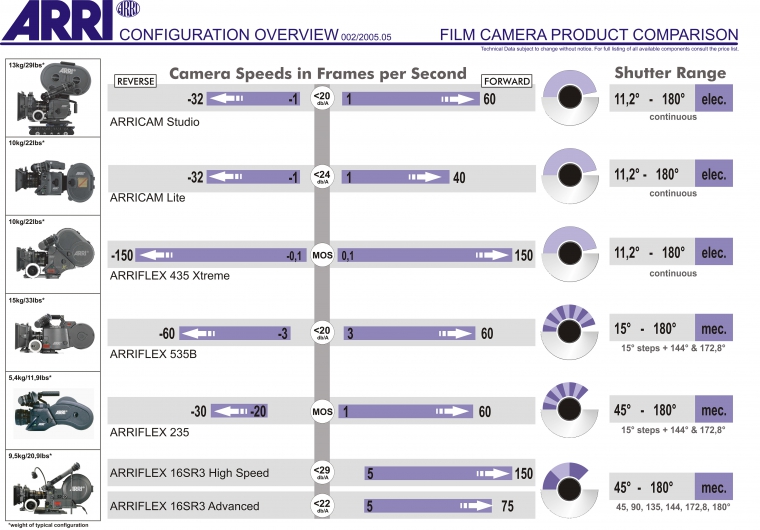
|
| |
| Aaton XTR camera serials build |
XTR 1986 - 1992 #1300 - #1785
Top speed is 54 fps.
Uses magnetic drive.
Super 16
Option L - Lightmeter
Option R - Beamsplitter for VR30 tube tap.
Option T - AatonCode.
X0plus 1992 - 1994 #1785 - #1900
Top speed is 60 fps (Bi-Phase Motor).
Uses magnetic drive.
Super 16.
Screw-in 15mm front rods.
Upgradeable to XTRplus.
Option R - Capacity for integrated CCD tap.
XTRplus 1992 - 1994 #1785 - #1900
Top speed is 60 fps (Bi-Phase Motor).
Magnetic Drive.
Super 16.
Screw-in 15mm rods.
Option L - Lightmeter.
Option R-Dir - Video Assist.
Option T - AatonCode.
Side Display.
Low Power Tri-phase Motor / Electronics
X0plus 1994 - 1996 #1900 - above
Top Speed 75fps
Magnetic Drive
Super16
Screw-in 15mm Rods
Low Power Tri-phase Motor / Electronics
Designed to be upgraded to XTRplus
XTRplus 1994 - 1996 #1900 - above
Top Speed 75 fps.
Magnetic Drive.
Super 16.
Screw-in 15mm rods.
Option L - Lightmeter.
Option R-Dir - Video Assist.
Option T - AatonCode.
Side Display.
Low Power Tri-phase Motor / Electronics
XTRprod 1994 - 1996 #1900 - above
Top Speed 75 fps.
Magnetic Drive.
Super 16.
Screw-in 15mm rods.
Option L - Lightmeter.
Option R-Dir - Video Assist.
Option T - AatonCode.
Illuminated Side Display
Low Power Tri-phase Motor / Electronics
Multi-position Shutter
Removable, swapable fibrescreen.
Aatonite Illuminated Viewing.
Built-in Speed Control in .001 increments. |
| |
| Film camera Manuals |
|
|
Aaton35-3
Aaton Penelope
Aaton Extera - 16mm
Aaton XTR Prod - 16mm
Aaton LTR - 16mm
Aaton Minima - 16mm
Aaton viewing screens (ground glasses)
Arri Groundglasses
Arri 235
Arricam LT and ST
Arri 435ES
Arri IVS 435
Arri 535B
Arri IVS 535/SR3
Arri 416
Arri BL - 16mm
Arri SR3 - 16mm
Beaulieu R16 - 16mm
Eclair ACL 1
Eclair ACL 2
Moviecam Compact
Moviecam SL
Mitchell Fries 35R 1
Mitchell Fries 35R 3
Panavision Millenium
Krasnogorsk K3
|
| |
| Cooke zoom lenses history |
From the Cooke Optics website:
 1971 Lens designer Gordon H. Cook designed the 35mm Cooke 20-100mm, T3.1 Varotal zoom lens, released in 1971. It was the first high quality zoom designed for professional motion picture photography that incorporated a totally new design concept that has remained the basis for all Cooke zoom lenses subsequently produced. It was produced through the late 1980s.
The lens was made with a sealed front focus unit and fixed front element that eliminated the risk of dirt and moisture being drawn into the lens and allowed for easy fitting of matte boxes and filter holders onto the front. The lens was enhanced with anti-reflective wide-band Varomag high performance coatings. This advanced technology achieved new standards in shadowed area definition, light transmission and durability, in addition to giving ghost and flare-free characteristics.
Gordon H. Cook received the 1988 Academy of Motion Picture Arts and Sciences, Gordon E. Sawyer Award for this and other technological advancements during his career as an optical designer.
In the 1980s, Cooke introduced Super 16mm and 35mm zoom lenses in different focal ranges:
Cooke Varokinetal (CVK) 9-50mm
The 16mm version of the Cooke 10.4-52mm lens, this lens was introduced in 1975.
Cooke Super Cine Varotal 25-250mm
With an aperture of f/2.8, it was ideal for special effects and was used to shoot the original Superman film in 1978, the year it was introduced.
Cooke Super 16 Varokinetal 10.4-52mm
This lens was first used by American cinematographer Curtis Clarke to film "The Draughtsman’s Contract," the first technically and commercially successful Super 16 feature to be made. The CVP offered advancements in filming under difficult lighting conditions in 16mm and Super 16mm formats. It began production in 1983. The Cooke 20-60mm was the 35mm equivalent to this lens.
Cooke Varopanchro, 20-60mm, T3.1
Epitomised 35mm zoom lens design, with an optical performance comparable to the finest prime lenses. Introduced in 1981.
Cooke Varopanchro (CVP) 10-30mm, T1.6
The CVP offered advancements in filming under difficult lighting conditions in 16mm and Super 16mm formats. It began production in 1983. The Cooke 20-60mm was the 35mm equivalent to this lens.
Cooke Cine Varotal 25-250mm, Mark II, T3.9
Introduced in 1983.
Cooke Wide Angle Varotal, 14-70mm, T3.1
During the development stage in the mid-1980s, valuable input was received from various customers, which prompted the company to incorporate an innovative curved front cover glass, and a noise isolator. This lens was unique in the zoom series because it included a wide angle aspheric. It was launched in 1986.
In 1988 Cooke lens designer, Gordon H. Cook, received The Academy of Motion Picture Arts and Sciences Gordon E. Sawyer Award "in recognition of technological contributions that brought credit to the film industry." It was the first time this Oscar category was awarded to someone outside the United States and is the highest accolade bestowed on an individual by the Academy for technical contributions to the film industry.
Gordon Cook designed cine and television lenses during the 1960s; most notably zooms that would meet the exacting requirements of the most discriminating cinematographer.
Feature films produced in the 1980s using Cooke lenses include Superman II, Star Wars, Ghandi, and Apocalypse Now.
Cooke Varotal 18-100mm
Design was initiated at the beginning of 1987 and the lens was exhibited for the first time at Photokina in 1988. It included refinements indicated by intensive market research into operator requirements.
Cooke Cinetal 25-250mm, Mark III, T3.7
Introduced in 1992. |
| |
| Wikipedia Tech links |
Circle of confusion - http://en.wikipedia.org/wiki/Circle_of_confusion |
| |

 Zeiss CP.2 Under Sensor Overlays
Zeiss CP.2 Under Sensor Overlays Super 16mm Under Sensor Overlays
Super 16mm Under Sensor Overlays The lines over the sensor indicate different recording areas and aspect ratios. The area outside the 6K image isn’t covered by a Super 35mm lens.
The lines over the sensor indicate different recording areas and aspect ratios. The area outside the 6K image isn’t covered by a Super 35mm lens.
 Sensor Overlays
Sensor Overlays







 1971
1971